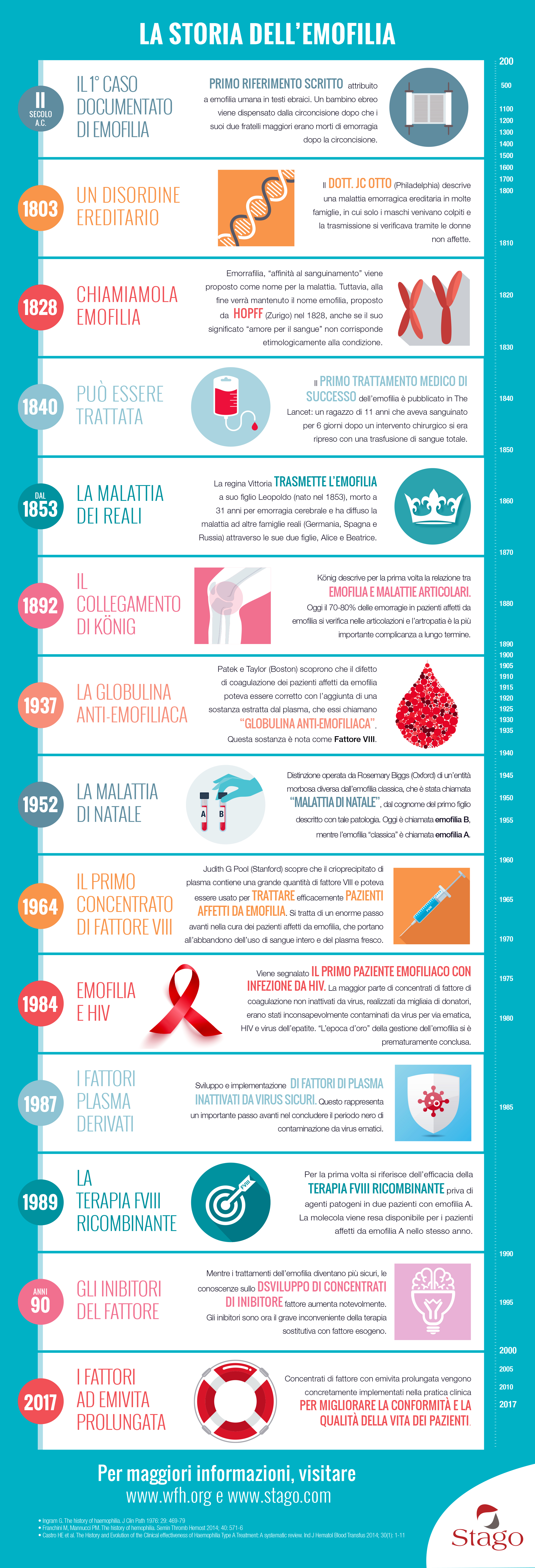
200 A.D.

The 1st documented case of haemophilia
First written reference attributed to human haemophilia in Hebrew texts. A Jewish baby is exempt of being circumcised after his two elder brothers had died of bleeding after circumcision.
1803

A hereditary disorder
Dr JC Otto (Philadelphia) describes an inheritable bleeding disorder in several families, in which only males were affected and transmission occurred via unaffected women.
1828

Let's call it Haemophilia
Haemorraphilia, "affinity to bleed", is proposed to name the disease. However, haemophilia, proposed by HOPFF (Zurich) in 1828 will finally be retained, even if its significance "love of blood" do not correspond etymologically with the condition.
1840

It can be treated
First successful medical treatment of haemophilia is published in The Lancet: an 11-year old boy who had bled 1845 for 6 days after surgery recovered with whole blood transfusion.
1853

The royal disease
An American vet observes a large number of deaths through bleeding in cattle that had eaten mouldy sweet clover. The doctor Karl LINK and collaborators identify the molecule responsible in this clover: dicoumarol, the antidote for which is vitamin K.
1892

The könig connection
König describes for the first time relationship between haemophilia and joint disease. Today 70-80% of blee- ding in haemophiliac patients occur in the joints and arthropathy is the most important long term complication.
1937

The anti-haemophilic globulin
Patek and Taylor (Boston) find that the coagulation defect of haemophiliac patients could be corrected by adding a substance extracted from plasma, which they call "anti-haemophilic globulin". This substance is actually known as Factor VIII.
1952

The christmas disease
Distinction by Rosemary Biggs (Oxford) of a disease entity different from classic haemophilia, which has been called "Christmas disease", after the last name of the first child described with the condition. It is now called haemophilia B, while "classic" haemophilia is called haemophilia A.
1964

The first factor VIII concentrate
Judith G Pool (Stanford) finds that plasma cryoprecipitate contains a large amount of factor VIII and could be used to efficiently tread haemophiliac patients. This is an enormous step forward in haemophiliac patients’ care, forsaking the use of whole blood and fresh plasma.
1984

Haemophilia and HIV
First Haemophiliac patient with HIV infection is reported. Most of non-virus-inactivated clotting factor concentrates, made from thousands donors, were unknowingly contaminated by blood-borne viruses, HIV and hepatitis viruses. The "golden era" of haemophilia management is prematurely ended.
1987

The plasma-derived factors
Development and implementation of safe virus inactivated plasma-derived factors. This represents a major breakthrough ending the black period of blood borne viruses contamination.
1989

The recombinant FVIII therapy
First report of the efficiency of pathogen-free recombinant FVIII therapy in two patients with Haemophilia A. The molecule become available for haemophilia A patients in the same year.
1990

The factor inhibitors
While treatments of haemophilia become safer, knowledge about the
development of inhibitor against factor concentrates greatly increases. Inhibitors are now the major drawback of exogenous factor replacement therapy.exploration path of hemostasis.
2017

The prolonged half-life factors
Prolonged half-life factor concentrates are actually being implemented in clinical practice to improve patient's compliance and quality of life.
